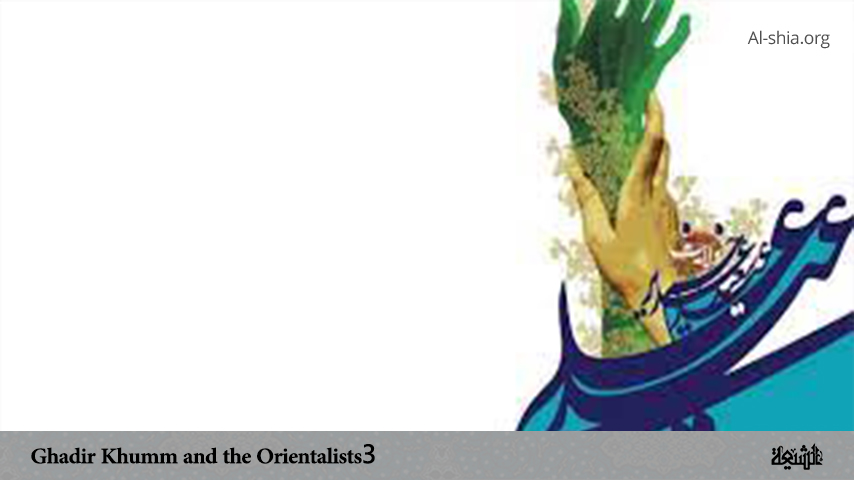In this article titled “Ghadir Khumm and the Orientalists”, we shall continue with the discussion on another Orientalist’s perspective on the event of Ghadir Khumm.
Ghadir Khumm: From Oblivion to Recognition
Another striking example of the Orientalists’ ignorance about Shi’ism is A Dictionary of Islam (1965) by Thomas Hughes. Under the entry of Ghadir, he writes, “A festival of the Shi’ahs on the 18th of the month of Zu ‘l-Hijjah, when three images of dough filled with honey are made to represent Abu Bakr, ‘Umar, and ‘Uthman, which are struck with knives, and the honey is sipped as typical of the blood of the usurping Khalifahs. The festival is named for Ghadir, ‘a pool,’ and the festival commemorates, it is said, Muhammad having declared ‘Ali his successor at Ghadir Khum, a watering place midway between Makkah and al-Madinah.”(1)
Coming from a Shi’a family that traces its ancestry back to the Prophet himself, having studied in Iran for ten years and lived among the Shi’as of Africa and North America, I have yet to see, hear or read about the dough and honey ritual of Ghadir! I was more surprised to see that even Vaglieri, in the second edition of the Encyclopaedia, has incorporated that nonsense into her fairly excellent article on Ghadir Khumm. She adds at the end, “This feast also holds an important place among the Nusayris.” It is quite possible that the dough and honey ritual is observed by the Nusayris; it has nothing to do with the Shi’as. But, do all Orientalists know the difference between the Shi’as and the Nusayrisa I very much doubt so.
A fourth example from contemporary scholars who have treated the same path is Philip Hitti in his History of the Arabs (1964). After mentioning that the Buyids established “the rejoicing on that [day] of the Prophet’s alleged appointment of ‘Ali as his successor at Ghadir Khumm,” he describes the location of Ghadir Khumm in the footnote as “a spring between Makkah and al-Madinah where Shi’ite tradition asserts the Prophet declared, ‘Whomsoever I am the lord of, his lord is ‘Ali also’.”(2) Although this scholar mentions the issue of Ghadir in a passing manner, he classifies the hadith of Ghadir is a “Shi’ite tradition”.
To these scholars who, consciously or unconsciously, have absorbed the Sunni bias against Shi’ism and insist on the Shi’ite origin or invention of the hadith of Ghadir, I would just repeat what Vaglieri has said in the Encyclopedia of Islam about Ghadir Khumm: It is, however, certain that Muhammad did speak in this place and utter the famous sentence, for the account of this event has been preserved, either in a concise form or in detail, not only by al-Ya’kubi, whose sympathy for the ‘Ali cause is well known, but also in the collection of traditions which are considered canonical, especially in the Musnad of Ibn Hanbal; and the hadiths are so numerous and so well attested by the different isnads that it does not seem possible to reject them. (3)
Vaglieri continues, “Several of these hadiths are cited in the bibliography, but it does not include the hadith which, although reporting the sentence, omit to name Ghadir Khumm or those which state that the sentence was pronounced at al-Hudaybiya. The complete documentation will be facilitated when the Concordance of Wensinck has been completely published. In order to have an idea of how numerous these hadiths are, it is enough to glance at the pages in which Ibn Kathir has collected a great number of them with their isnads.”
It is time that Western scholarship made itself familiar with the Shi’ite literature of the early days as well as of the contemporary period. The Shi’a scholars have produced great works on the issue of Ghadir Khumm. Here I will just mention two of those:
1. The first is ‘Abaqatu ‘l-Anwar in eleven bulky volumes written in Persian by Mir Hamid Husayn al-Musawi (d. 1306 AH) of India. ‘Allamah Mir Hamid Husayn has devoted three bulky volumes (consisting of about 1080 pages) on the isnad, tawatur and meaning of the hadith of Ghadir. An abridged version of this work in Arabic translation entitled as Nafahatu ‘l-Azhar fi Khulasati ‘Abaqati ‘l-Anwar by Sayyid ‘Ali al-Milani has been published in twelve volumes now, and four volumes of these (with modern type-setting and printing) are dedicated to the hadith of Ghadir.
2. The second work is al-Ghadir in eleven volumes in Arabic by ‘Abdul Husayn Ahmad al-Amini (d. 1970) of Iraq. ‘Allamah Amini has given with full references the names of 110 companions of the Prophet and also the names of 84 tabi’in (disciples of the companions) who have narrated the hadith of Ghadir. He has also chronologically given the names of the historians, traditionalists, exegetists and poets who have mentioned the hadith of Ghadir from the first till the fourteenth Islamic century.
The late Sayyid ‘Abdu ‘l-‘Aziz at-Tabataba’i has stated that there probably is not a single hadith that has been narrated by so many companions as the number we see (120) in the hadith of Ghadir. However, comparing that number to the total number of people who were present in Ghadir Khumm, he states that 120 is just ten percent of the total audience. And so he rightly gave the following title to his paper: “Hadith Ghadir: Ruwatuhu Kathiruna lil-Ghayah…Qalaluna lil-Ghiyah – Its Narrators are Very Many…Very Few”.(4)
Continued in the next article: ( http://Ghadir Khumm and the Orientalists 4)
NOTES:
___________________________________________
1. Hughes, Thomas P., A Dictionary of Islam (New Jersey: Reference Book Publishers, 1965) p. 138.
2. Hitti, P.K., History of the Arabs (London: Macmillan & Co., 1964) p. 471.
3. EI2, p. 993 under “Ghadir Khumm”.
4. At-Tabataba’i, ‘Abdu ‘l-‘Aziz, al-Ghadir fi ‘t-Turathi ‘l-Islami ( Qum : Nashr al-Hadi, 1415) p. 7-8.


















